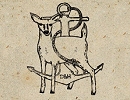Contact Seller
Doe And Hope
Tel07729 213013Please quote Antiques Atlas.


 Alabaster sculpture depicting Cupid. 19th century.
Alabaster sculpture depicting Cupid. 19th century.
 17th Century Sculpture of the Lady of Sorrow
17th Century Sculpture of the Lady of Sorrow
 19th century French terracotta sculpture God Pan
19th century French terracotta sculpture God Pan
 Vintage Spanish Bronze Sculpture
Vintage Spanish Bronze Sculpture
 Silver Alloy Figure Of Shiva. Eastern Java,15/16th
Silver Alloy Figure Of Shiva. Eastern Java,15/16th
 Antique Statue
Antique Statue
 Circle of Life Sculpture - Jennine Parker
Circle of Life Sculpture - Jennine Parker
 Large Sculpture of Mary & The Infant Christ c.1960
Large Sculpture of Mary & The Infant Christ c.1960
 Great Patinated Stucco Sculpture 20th Century
Great Patinated Stucco Sculpture 20th Century
 Surrealist Ceramic Sculpture LuAnne TackettSimpson
Surrealist Ceramic Sculpture LuAnne TackettSimpson
 Surrealist Ceramic Sculpture LuAnne TackettSimpson
Surrealist Ceramic Sculpture LuAnne TackettSimpson
 Art Deco Sculpture Girl & Greyhounds by Geo Maxim
Art Deco Sculpture Girl & Greyhounds by Geo Maxim
Non UK callers :
+44 7729 213013
‘The Greek Slave’ After Hiram Powers c.1844-70


1 of 6
The half-scaled size plaster figure, modelled as The Greek Slave by Hiram Powers of 1844, depicting a young woman, nude, bound in chains and standing on a circular plinth base surviving from the middle of nineteenth century England.
The condition of the figure is mainly sound though she has obvious repairs, the head has once been detached and reattached, as has one arm, the glaze is worn in places making her decorative, and there is a missing small piece to the neck as pictured.
The Greek Slave, the first publicly exhibited, life-size, American sculpture depicting a fully nude female figure, met with unprecedented popular and critical success. Arguably the most famous American sculpture ever, The Greek Slave not only won American expatriate Hiram Powers international acclaim but also enhanced the overseas reputation of American art and culture. After completing his first Greek Slave in 1844 (Raby Castle, England), Powers produced five full-size versions (also in marble), each slightly different. William Wilson Corcoran purchased this sculpture, the first of those, in 1851.
Powers chose a subject inspired by Greece's struggle for independence in the 1820s many literary, artistic, and critical responses to the sculpture linked it to the ongoing debate over American slavery. In Florence, Powers was overwhelmed by the demand for more full-size versions and busts. The sculpture's renown also permeated popular culture, inspiring everything from miniature reproductions and chewing-tobacco tins to poetry and sheet music.
Powers himself described the subject of the work thus:
‘The Slave has been taken from one of the Greek Islands by the Turks, in the time of the Greek revolution, the history of which is familiar to all. Her father and mother, and perhaps all her kindred, have been destroyed by her foes, and she alone preserved as a treasure too valuable to be thrown away. She is now among barbarian strangers, under the pressure of a full recollection of the calamitous events which have brought her to her present state and she stands exposed to the gaze of the people she abhors, and awaits her fate with intense anxiety, tempered indeed by the support of her reliance upon the goodness of God. Gather all these afflictions together, and add to them the fortitude and resignation of a Christian, and no room will be left for shame’.
Beginning as a clay model, The Greek Slave followed an arc of production that was typical of nineteenth-century marble sculpture. Powers entrusted his full-scale clay model to formatori, professional mold makers who built a plaster form around the finished clay, capturing contours and surface details in a negative impression.
This particular model is very similar aesthetically to the one held in the Smithsonian American Art Museum. Figures in parianware, and the like, were created by Minton in smaller sizes, but to find one of this size of the period in plaster is rare, and we cannot find another example having been recently offered for sale.
A timeless and enduring piece and one of the most famous sculptures of the nineteenth century.
SellerDoe And Hope
View all stock from
Doe And Hope

 Private dealer, By appointment only
Private dealer, By appointment only
The Onion Barn, Shoe Cottage,
15 High Street, Blunham,
Bedfordshire, MK44 3NL.
MK44 3NL
Tel : 07729 213013
Non UK callers : +44 7729 213013
Get directions to Doe And Hope
The condition of the figure is mainly sound though she has obvious repairs, the head has once been detached and reattached, as has one arm, the glaze is worn in places making her decorative, and there is a missing small piece to the neck as pictured.
The Greek Slave, the first publicly exhibited, life-size, American sculpture depicting a fully nude female figure, met with unprecedented popular and critical success. Arguably the most famous American sculpture ever, The Greek Slave not only won American expatriate Hiram Powers international acclaim but also enhanced the overseas reputation of American art and culture. After completing his first Greek Slave in 1844 (Raby Castle, England), Powers produced five full-size versions (also in marble), each slightly different. William Wilson Corcoran purchased this sculpture, the first of those, in 1851.
Powers chose a subject inspired by Greece's struggle for independence in the 1820s many literary, artistic, and critical responses to the sculpture linked it to the ongoing debate over American slavery. In Florence, Powers was overwhelmed by the demand for more full-size versions and busts. The sculpture's renown also permeated popular culture, inspiring everything from miniature reproductions and chewing-tobacco tins to poetry and sheet music.
Powers himself described the subject of the work thus:
‘The Slave has been taken from one of the Greek Islands by the Turks, in the time of the Greek revolution, the history of which is familiar to all. Her father and mother, and perhaps all her kindred, have been destroyed by her foes, and she alone preserved as a treasure too valuable to be thrown away. She is now among barbarian strangers, under the pressure of a full recollection of the calamitous events which have brought her to her present state and she stands exposed to the gaze of the people she abhors, and awaits her fate with intense anxiety, tempered indeed by the support of her reliance upon the goodness of God. Gather all these afflictions together, and add to them the fortitude and resignation of a Christian, and no room will be left for shame’.
Beginning as a clay model, The Greek Slave followed an arc of production that was typical of nineteenth-century marble sculpture. Powers entrusted his full-scale clay model to formatori, professional mold makers who built a plaster form around the finished clay, capturing contours and surface details in a negative impression.
This particular model is very similar aesthetically to the one held in the Smithsonian American Art Museum. Figures in parianware, and the like, were created by Minton in smaller sizes, but to find one of this size of the period in plaster is rare, and we cannot find another example having been recently offered for sale.
A timeless and enduring piece and one of the most famous sculptures of the nineteenth century.
Price The price has been listed in British Pounds.
Conversion rates as of 13/FEB/2025. Euro & Dollar prices will vary and should only be used as a guide.
Always confirm final price with dealer. Phone or visit the website to buy, Free UK shipping.
Category Busts and Figures
Date c.1844-1870
Mid Victorian Antiques Material Plaster
Origin English
Item code as155a1800 / 1868
Status Sold
£1850.00 
$2316.76 
€2220.56 

$

€

Conversion rates as of 13/FEB/2025. Euro & Dollar prices will vary and should only be used as a guide.
Always confirm final price with dealer. Phone or visit the website to buy, Free UK shipping.
View all stock from
Doe And Hope

 Private dealer, By appointment only
Private dealer, By appointment onlyThe Onion Barn, Shoe Cottage,
15 High Street, Blunham,
Bedfordshire, MK44 3NL.
MK44 3NL
Tel : 07729 213013
Non UK callers : +44 7729 213013
Get directions to Doe And Hope
You may also be interested in
 Alabaster sculpture depicting Cupid. 19th century.
Alabaster sculpture depicting Cupid. 19th century.
 17th Century Sculpture of the Lady of Sorrow
17th Century Sculpture of the Lady of Sorrow
 19th century French terracotta sculpture God Pan
19th century French terracotta sculpture God Pan
 Vintage Spanish Bronze Sculpture
Vintage Spanish Bronze Sculpture
 Silver Alloy Figure Of Shiva. Eastern Java,15/16th
Silver Alloy Figure Of Shiva. Eastern Java,15/16th
 Antique Statue
Antique Statue
 Circle of Life Sculpture - Jennine Parker
Circle of Life Sculpture - Jennine Parker
 Large Sculpture of Mary & The Infant Christ c.1960
Large Sculpture of Mary & The Infant Christ c.1960
 Great Patinated Stucco Sculpture 20th Century
Great Patinated Stucco Sculpture 20th Century
 Surrealist Ceramic Sculpture LuAnne TackettSimpson
Surrealist Ceramic Sculpture LuAnne TackettSimpson
 Surrealist Ceramic Sculpture LuAnne TackettSimpson
Surrealist Ceramic Sculpture LuAnne TackettSimpson
 Art Deco Sculpture Girl & Greyhounds by Geo Maxim
Art Deco Sculpture Girl & Greyhounds by Geo Maxim








